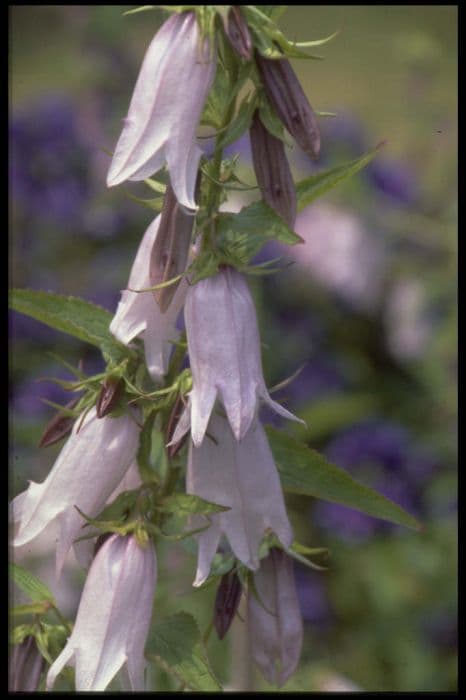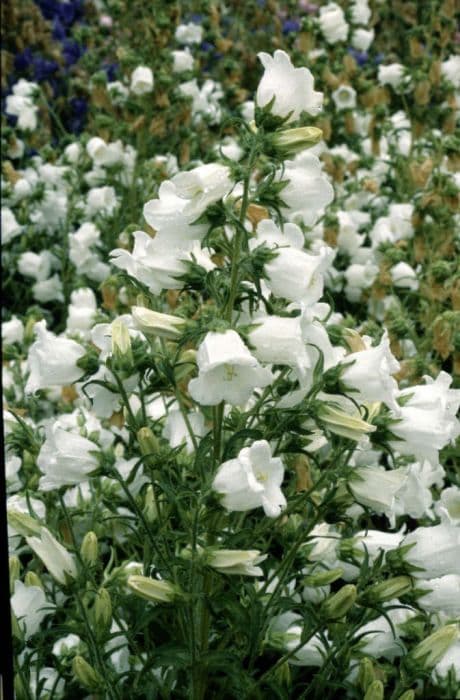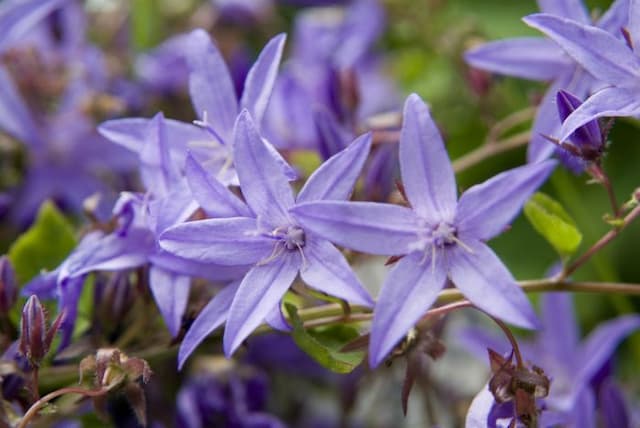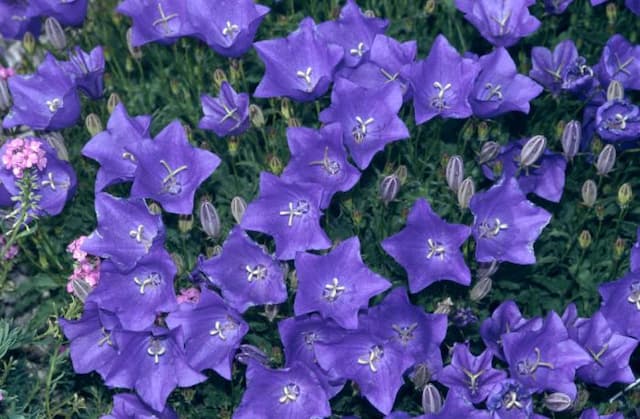Edging Lobelia Lobelia erinus 'Regatta Midnight Blue'

ABOUT
Lobelia erinus 'Regatta Midnight Blue' is a captivating ornamental plant known for its rich, deep blue flowers. These blossoms are notable for their tubular shape, with the petals often featuring a delicate fan-like form that gives them a significant appeal. The throat of each flower is accented with a conspicuous white eye, creating a striking contrast against the dark blue petals that seem almost velvet-like in texture. The foliage of the plant is a vibrant green, forming a lush backdrop for the intensity of the blooms. Leaves are typically small and narrow, adding a fine texture to the overall appearance of the plant. Together, the profusion of blue flowers against the green foliage creates a brilliant display of color that is both eye-catching and elegant. The 'Regatta Midnight Blue' variety stands out with its distinctive hue, making it a favored choice for gardeners looking to add a splash of cool color to their landscape. In summary, the appearance of Lobelia erinus 'Regatta Midnight Blue' is marked by its luxurious dark blue flowers with a white center, tubular and fan-shaped petals, surrounded by dense, narrow green leaves that together provide a beautiful contrast and rich texture.
About this plant
 Names
NamesFamily
Campanulaceae.
Synonyms
Edging Lobelia, Garden Lobelia, Trailing Lobelia, Bedding Lobelia, Cascade Lobelia, Fountain Lobelia.
Common names
Lobelia erinus 'Regatta Midnight Blue'.
 Toxicity
ToxicityTo humans
Lobelia, including the Lobelia erinus species, contains several alkaloids such as lobeline that can be toxic when ingested in significant quantities. While the plant is not typically considered dangerously toxic to humans, consuming it can lead to symptoms such as nausea, vomiting, diarrhea, cough, dizziness, and excessive salivation. In severe cases, and especially if large amounts are ingested, it may potentially result in more serious effects like convulsions or heart problems. It is advisable for humans to avoid ingesting Lobelia erinus or any part of it due to its potential toxicity.
To pets
Lobelia is also potentially toxic to pets such as dogs and cats. Ingestion can cause vomiting, diarrhea, excessive drooling, lethargy, and weakness. In some cases, more severe symptoms such as difficulty breathing, rapid heartbeat, or even collapse might occur. Although it may not be among the most toxic plants for pets, it's still best to prevent your pets from consuming Lobelia erinus or any part of it to avoid the risk of poisoning.
 Characteristics
CharacteristicsLife cycle
Annuals
Foliage type
Evergreen
Color of leaves
Green
Flower color
Blue
Height
0.5 feet (15 cm)
Spread
0.5 feet (15 cm)
Plant type
Herb
Hardiness zones
10
Native area
South Africa
Benefits
 General Benefits
General Benefits- Attracts Pollinators: The vibrant blue flowers of Lobelia are known to attract bees and butterflies, which can help pollinate nearby plants.
- Aesthetic Appeal: Adds striking color contrast with its deep blue flowers and can enhance the beauty of any garden or landscape.
- Easy to Grow: Lobelia is generally easy to care for and can thrive in a variety of conditions, making it suitable for novice gardeners.
- Container Gardening: Ideal for pots, hanging baskets, and window boxes due to its trailing habit and compact size.
- Borders and Edging: Can be used to create defined edges in garden beds or along walkways, adding to the structural design of the garden.
- Seasonal Color: Offers prolonged flowering throughout the spring and summer, providing consistent color in the garden landscape.
- Companion Planting: Serves as a good companion plant due to its compact growth habit, fitting well with other plants without overpowering them.
 Medical Properties
Medical PropertiesThis plant is not used for medical purposes.
 Air-purifying Qualities
Air-purifying QualitiesThis plant is not specifically known for air purifying qualities.
 Other Uses
Other Uses- Temporary tattoo ink: The deep blue pigment from Lobelia erinus can be used to create a natural temporary tattoo ink.
- Botanical illustration: Due to its vibrant blue flowers, it is commonly used as a subject in botanical illustration classes and workshops.
- Fabric dye: The flowers can be used to produce a non-toxic dye for fabrics, yielding a light blue hue.
- Cultural ceremonies: Certain cultures might use the flowers for decorating venues during ceremonies to signify tranquility and peace.
- Floral ice cubes: The small flowers can be frozen in ice cubes to create decorative elements for summer drinks.
- Photography prop: The plants are often used in horticultural photography to add vivid color and depth to garden scenes.
- Beekeeping attraction: Lobelia erinus can be planted near beehives to attract bees for pollination, aiding in the health of the hive.
- Pressed flower art: The flowers can be pressed and used in crafting to make bookmarks, greeting cards, or framed art pieces.
- School projects: This plant is utilized in school biology projects to teach students about pollination and the life cycle of flowering plants.
- Natural confetti: When dried, the petals of Lobelia can be used as biodegradable confetti for eco-friendly celebrations.
Interesting Facts
 Feng Shui
Feng ShuiThe Lobelia is not used in Feng Shui practice.
 Zodiac Sign Compitability
Zodiac Sign CompitabilityThe Lobelia is not used in astrology practice.
 Plant Symbolism
Plant Symbolism- Perseverance: This variety of Lobelia is known for its ability to flourish in a variety of growing conditions, symbolizing the ability to persevere through challenges.
- Hope and Peace: The vibrant blue flowers are often associated with tranquility and calmness, representing a sense of hope and peace for the future.
- Attraction: With its rich blue hues, the 'Regatta Midnight Blue' is said to symbolize attraction, drawing in both people and pollinators alike.
- Good Fortune: In some traditions, the color blue is considered lucky, so this plant may also represent good fortune and prosperity.
 Water
WaterThe Lobelia, specifically the 'Regatta Midnight Blue', should be watered regularly to maintain consistently moist soil, but it is important to ensure that the soil is not waterlogged. A good rule of thumb is to water the plant once or twice a week, depending on the local climate and season. During hot and dry periods, you might need to water more frequently. Provide about one inch of water each time to sufficiently hydrate the roots without over-saturating the soil. Adjust the amount and frequency based on rainfall and temperature conditions to avoid overwatering.
 Light
LightLobelia 'Regatta Midnight Blue' thrives in a location that offers full sun to partial shade. The ideal spot would provide morning sunlight and some afternoon shade, especially in hotter climates, to protect the plant from intense midday heat. Ensure at least 3-4 hours of direct sunlight each day, allowing the flowers to bloom profusely and maintain their vibrant blue hue.
 Temperature
TemperatureLobelia 'Regatta Midnight Blue' prefers moderate to warm temperatures, thriving best in conditions between 60°F and 70°F. They can tolerate minimum temperatures down to about 40°F but are sensitive to frost. Avoid exposure to temperatures above 80°F for extended periods, as excessive heat can stress the plant and cause it to stop flowering.
 Pruning
PruningPruning Lobelia 'Regatta Midnight Blue' is essential to encourage bushier growth and more blooms. Deadheading, or removing spent flowers, can be done consistently throughout the blooming period to promote continuous flowering. Lightly prune the plant in early spring or after the first flush of flowers has faded to rejuvenate and stimulate new blooms. The best time for heavy pruning is late winter or early spring, before the onset of new growth.
 Cleaning
CleaningAs needed
 Soil
SoilEdging Lobelia prefers well-draining soil rich in organic matter with a slightly acidic to neutral pH between 6.0 to 7.0. A good mix would be peat-based potting soil with added perlite for aeration and vermicompost for nutrients.
 Repotting
RepottingEdging Lobelia typically doesn't need frequent repotting and does well being repotted every 1-2 years, especially when the plant outgrows its current container or the soil needs refreshing.
 Humidity & Misting
Humidity & MistingEdging Lobelia thrives in moderate to high humidity conditions, ideally between 50-70%. They are not suited to dry air environments and benefit from misting or a pebble tray to maintain humidity.
 Suitable locations
Suitable locationsIndoor
Ensure bright, indirect light and consistent moisture for Edging Lobelia.
Outdoor
Place in partial shade to full sun and keep soil consistently moist.
Hardiness zone
10-11 USDA
 Life cycle
Life cycleThe life of Lobelia 'Regatta Midnight Blue', commonly known as Trailing Lobelia, begins with seed germination, which occurs in warm temperatures and when adequate moisture is present. After seedlings emerge, they grow into juvenile plants, developing a rosette of leaves and a root system. As the plant matures, it enters the vegetative stage, producing a wealth of foliage and beginning to trail or spread, characteristic of this cultivar. The plant then starts to develop flower buds, which bloom into its striking deep blue flowers with a prominent white eye. After the blooming stage, if the conditions are favorable, it can enter a repeated bloom cycle, especially if spent flowers are deadheaded. Finally, as cooler temperatures and shorter days arrive, the plant's growth slows, and it completes its annual life cycle, typically dying off with the first frost.
 Propogation
PropogationPropogation time
Spring-early summer
Propogation: Lobelia, specifically the Lobelia erinus 'Regatta Midnight Blue', is most commonly propagated through seeds. The best time to start seed propagation is in late winter to early spring, which allows the lobelia seedlings to be ready for planting after the last frost. The process involves sprinkling the fine seeds onto the surface of a well-draining seed starting mix, as they require light to germinate, so they should not be covered with soil. After scattering, the seeds need to be kept moist and in a warm place with temperatures around 70 to 75 degrees Fahrenheit (21 to 24 degrees Celsius), which encourages germination. The seedlings typically emerge in 10 to 20 days and should be thinned or transplanted to individual pots when they are large enough to handle. They are normally ready to be moved outdoors once the risk of frost has passed and the seedlings have developed several true leaves.









